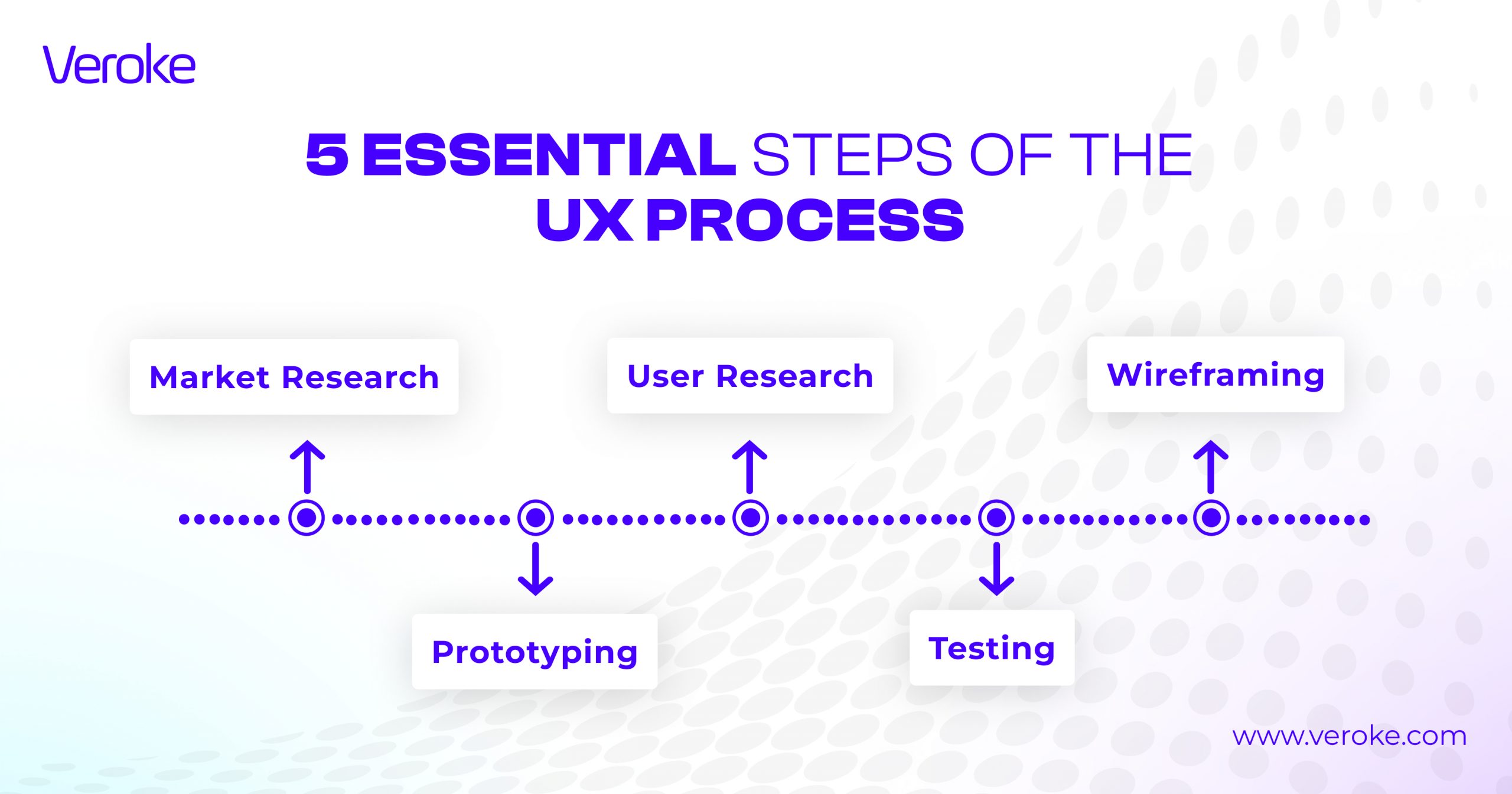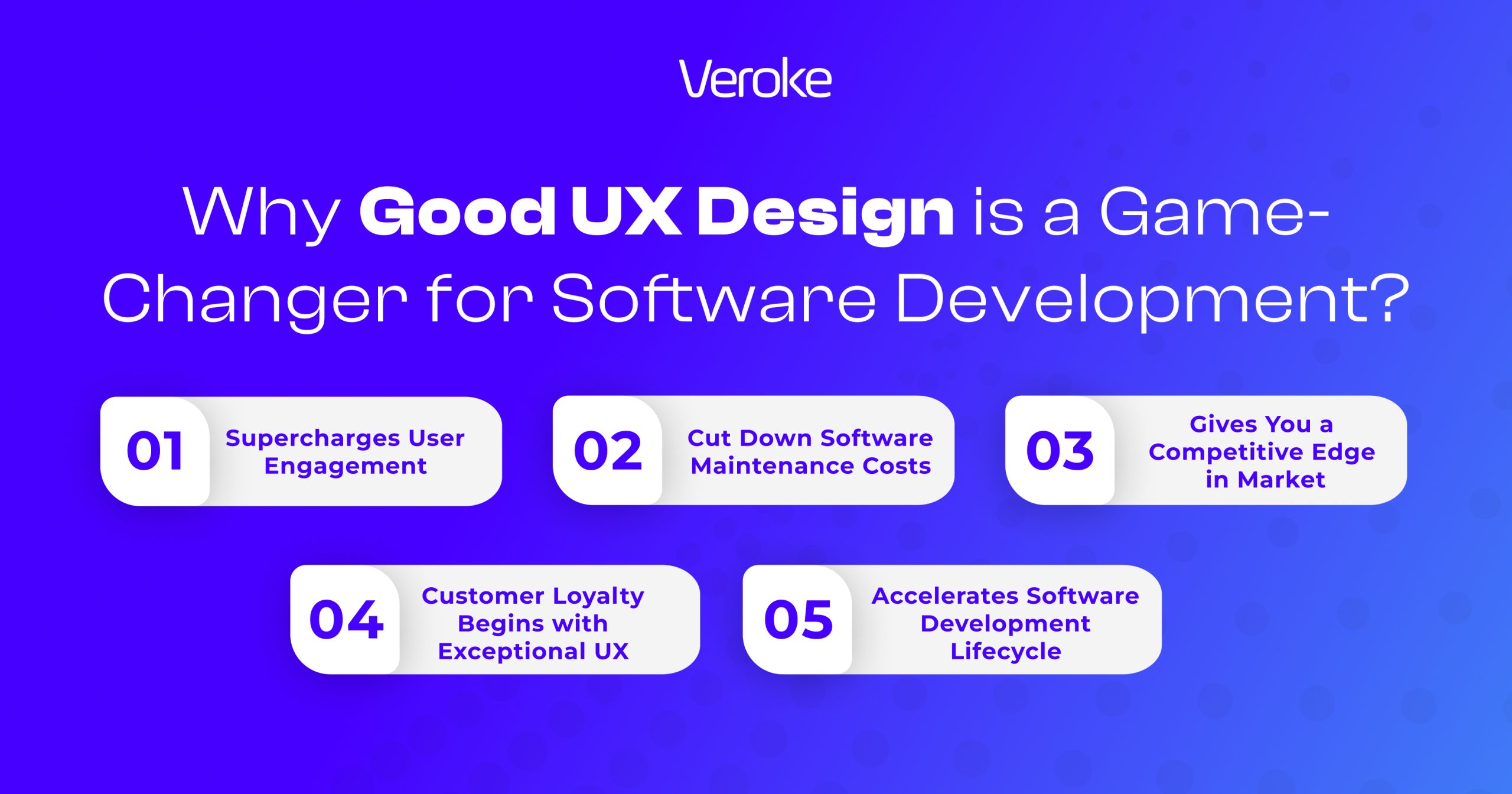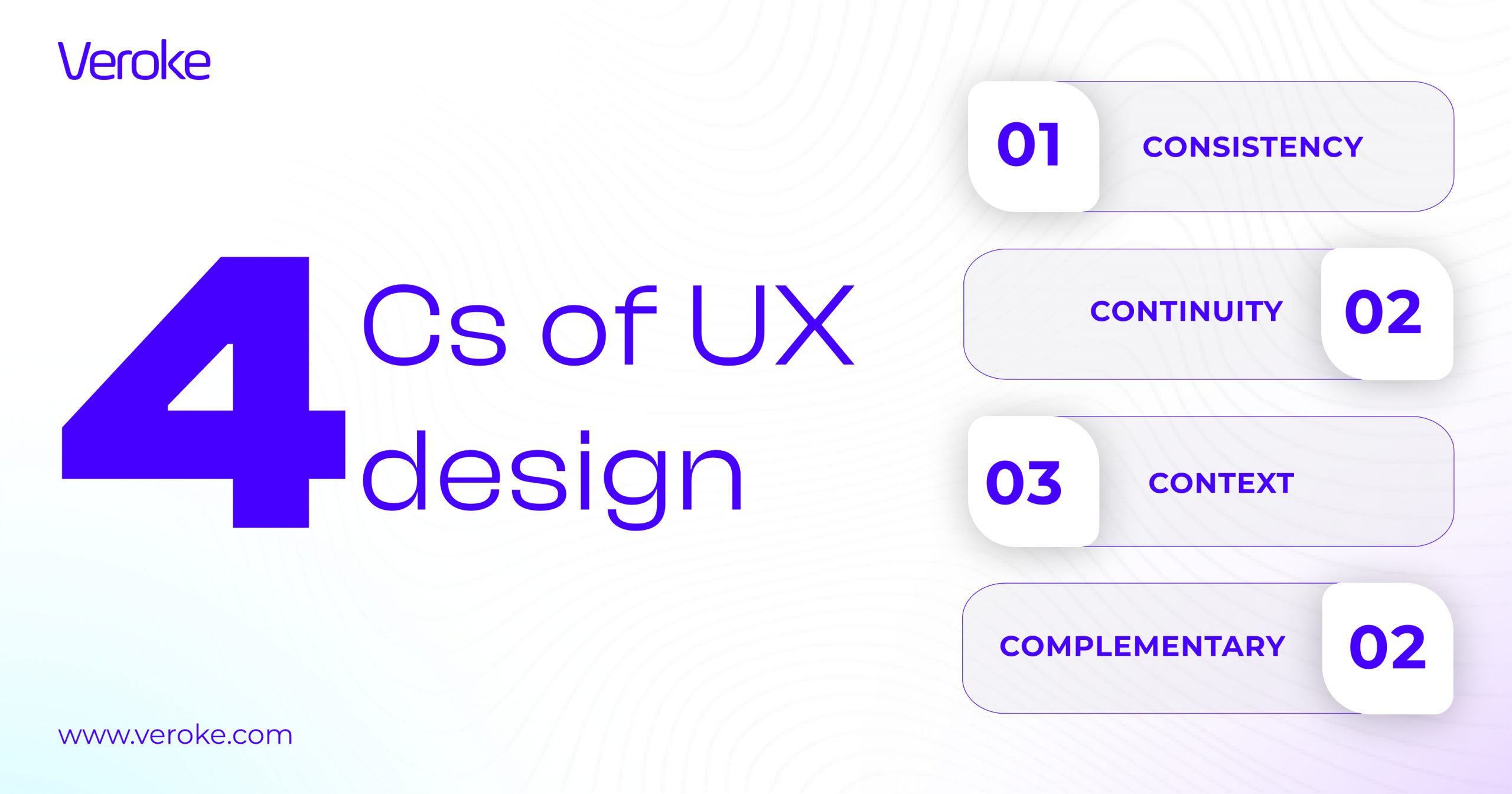Overview
Inside Saudi’s Tech Transformation
Get exclusive weekly insights into how the Kingdom is powering Vision 2030.
TL;DR
- Great UX keeps users interested, comfortable, and coming back – turning ordinary tools into delightful digital experiences.
- Prioritizing UX early prevents usability issues, minimizes redesigns, and lowers maintenance costs post-launch.
- A smooth, intuitive user experience differentiates your software from competitors and strengthens brand loyalty.
- UX-focused workflows streamline collaboration, enable faster iterations, and reduce rework.
- Consistency, Continuity, Context, and Complementary design principles ensure seamless, adaptive, and valuable user experiences across all devices.
In software development, good UX design isn’t just a bonus, it’s the difference between products that captivate users and those quickly forgotten.
Whether you’re creating an enterprise-level custom software solution, developing a SaaS platform, or building a mobile app for your business, delivering an exceptional user experience is essential for driving engagement, boosting retention, and ensuring long-term success.
And great UX design goes beyond aesthetics, it’s about creating intuitive, user-focused solutions that actually solve their problem. According to Forbes, 88% of online users are less likely to return to a site after a bad experience, underscoring how crucial UX is to customer loyalty and business growth.
In this read, we’ll uncover five compelling reasons why UX design is a true game-changer in software development, from cutting costs to gaining a competitive edge.
But before diving in, let’s explore the essential steps of the process that lay the foundation for creating seamless, user-centered software experiences.
Why Good UX Design is a Game-Changer for Software Development?
When it comes to software development, UX design is not just about impressive screens and cool buttons, it’s about keeping users in mind.
UX design in software engineering is what determines whether your users stay, engage, and recommend your product or abandon it altogether. And here’s the kicker: great UX starts with you taking the time to understand both the market and your users.
Let’s walk through the essential steps of the UX process and how each one helps you create software that users genuinely enjoy using.

Fundamental steps of the UX Design process
1) Market Research – Know Where You Stand
Before you dive into wireframes or interfaces, take a step back and look at the bigger picture. You need to understand your competitors and the market well.
Ask yourself:
- Who are your top competitors?
- What are they doing right, or what they are missing in terms of UX?
- How can your product do it better?
By analyzing existing products, you can spot gaps and turn them into opportunities. Maybe your competitors’ interfaces are clunky, or their onboarding process frustrates users.
This is your chance to improve on that and give users a better alternative.
2) User Research – Design for People
Here’s the truth: You can’t build great UX without knowing your users.
That means doing the work, talking to them, surveying them, and watching how they interact with your product. Learn what they like, what frustrates them, and what they wish existed.
By understanding their goals, habits, and challenges, you can:
- Build intuitive features that solve their problems
- Streamline interactions for speed and satisfaction
- Deliver value in every click or swipe
In short, the user experience research helps you make smarter design choices because you’re not guessing, you’re building based on real insights.
3) Wireframing – Sketch It Before You Build It
Now that you’ve done your research, it’s time to start mapping out your ideas, but keep it simple.
Wireframing helps you:
- Visualize the layout of your app or website
- Decide how users will move from screen to screen
- Avoid costly changes later in development
Think of wireframes as your blueprint. They let you quickly test ideas and validate flows before writing any code, saving you time and money in the long run.
4. Prototyping – Give Users Something to Click On
You’ve got your wireframes, now it’s time to make them interactive.
With prototyping, you create a working model of your software, simulating how users will navigate, tap, and interact with it.
This is where you can:
- Test whether your design actually makes sense
- Spot confusing areas or dead ends
- Gather feedback early and iterate fast
You get to experience your product the way your users will, before you invest in full-scale development.
5. Testing – Make Sure It Works for Everyone, Everywhere
You might love your design, but that doesn’t mean your users will. That’s why you need to test it on real devices in real conditions.
This includes:
- Checking how your UI looks on different screen sizes
- Making sure navigation is smooth across devices
- Ensuring accessibility and usability for all users
Don’t skip this step. It’s your chance to catch problems early, improve usability, and ensure your software performs reliably, no matter where it’s being used.
5 Reasons to Prioritize UX Design in Software Development
Here are five compelling reasons why integrating good UX design into your software development process is more than just a good practice; it’s a strategic advantage.

Top reasons to make UX design a priority
1. Good UX Design Supercharges User Engagement
Want users to keep coming back to your software? Then you need UX that captures their attention and keeps them involved. A well-thought-out user experience ensures that users feel comfortable, interested, and even delighted while using your product.
Because people naturally gravitate toward software that’s not only functional but also enjoyable and key role, it transforms a basic tool into a meaningful digital experience.
Having a clear understanding of users’ needs, preferences, and behaviors allows developers to design interfaces that are visually appealing, functional, and easy-to-use. This encourages higher user engagement, which directly translates into better user retention and higher revenue potential.
Think about it, would you keep using software that’s clunky or confusing, even if it gets the job done? Most users would rather stick with a product that offers a smooth, satisfying experience. That’s the power of good UX.
2. UX-Centric Design Helps Cut Down Software Maintenance Costs
Imagine launching a product that’s so well-designed, it barely needs fixing. Sounds great, right?
Design is not just limited to visually appealing screens, it’s also about usability and performance. When UX is prioritized from the beginning of the development cycle, it helps prevent issues that often lead to costly fixes post-launch. From minimizing bugs and errors to reducing the need for frequent redesigns, it can drastically cut down long-term maintenance costs.
By testing prototypes with real users and iterating based on actionable feedback, you catch potential problems early, before they snowball into expensive technical debt. Moreover, establishing effective feedback loops allows users to report issues proactively, enabling continuous improvement with minimal disruption.
Simply put: investing in good UX now means spending less on troubleshooting later.
3. UX Design Gives You a Competitive Edge in the Market
In a saturated software market, standing out is tough, but not impossible.
Good UX design can be your secret weapon. It provides a clear competitive advantage by delivering a user experience that your competitors simply can’t replicate. When your software solves users’ problems with elegance and ease, and makes them feel good while doing so, it becomes more than a tool; it becomes a trusted solution.
UX designers play a pivotal role in crafting unique and memorable experiences that resonate with users. When done right, UX showcases your value proposition in a way that sets you apart from lookalike competitors. It becomes part of your brand identity and contributes directly to user preference and loyalty.
4. Customer Loyalty Begins with Exceptional UX
Loyal customers don’t just stick around; they advocate for your product.
User satisfaction is closely tied to how they experience your software. A seamless, enjoyable interaction can lead to emotional attachment, fostering long-term relationships between users and your brand. This is especially crucial in B2B and SaaS environments, where recurring revenue depends on continuous engagement.
Great design fosters this connection by putting users first. When people feel heard, understood, and empowered through the software they use, they’re far more likely to stay loyal and recommend your product to others.
It’s not just about usability, it’s about creating a positive emotional journey that turns casual users into brand ambassadors.
5. Great UX Accelerates the Software Development Lifecycle
A good user experience and design also accelerates the development process.
Because it encourages active collaboration between users and developers. By involving end-users early on and maintaining continuous feedback loops, teams can make smarter, faster decisions. This leads to quicker iterations, fewer misunderstandings, and a shorter path from idea to implementation.
With clearly defined user needs guiding the process, steps like prototyping, testing, and refining become more efficient. The end result? A polished, user-centered product developed in less time and with fewer resources.
Ultimately, UX-focused development not only improves product quality, it optimizes the entire development workflow.
Understanding the 4 Cs of UX Design
A great user experience requires more than functionality and features in the current digital space. It’s about creating a coherent, intuitive, and adaptive journey for the user, no matter where or how they interact with your product.
That’s where the 4 Cs of UX Design come in: Consistency, Continuity, Context, and Complementary. These core principles help UX designers shape digital products that are not only usable but also memorable, scalable, and future-ready.
Let’s break down each of these pillars and understand how they collectively define a successful user experience strategy.

Understanding the 4 C’s of UX design
1. Consistency: Keep the Experience Familiar Across All Devices
Consistency is the backbone of a strong digital brand identity. From visual elements like typography, icons, and color palettes to interaction patterns and navigational flow, your product should feel familiar and intuitive at every touchpoint.
Why is this important? Because users expect a uniform experience across all platforms, whether they’re using your app on a smartphone, tablet, or desktop. Inconsistent UX can confuse users, disrupt workflows, and erode trust.
It ensures that your visual and functional language is carried across devices, making the experience predictable, intuitive, and professional. And when users know what to expect, they’re more likely to return and stay loyal.
2. Continuity: Design for a Seamless Multi-Device Journey
In this connected environment, users move effortlessly between devices, and they expect your software to keep up. A user might start a task on a mobile app during a commute, continue on a desktop at work, and wrap it up on a tablet at home.
This is where continuity in the design and the software engineering process plays a pivotal role.
Continuity ensures that users can transition smoothly between devices without losing context or progress. While features might vary slightly from one platform to another, the overall user experience should feel uninterrupted and cohesive.
Designing for continuity means syncing data across platforms, preserving user sessions, and maintaining familiar workflows. It’s about building a holistic experience that travels with the user.
3. Context: Design with the User’s Environment in Mind
Context-aware design is about meeting users where they are, not just digitally, but physically and emotionally.
The way users interact with your software depends on when, where, and how they use it. For example, a smartwatch app designed for glances during workouts should offer different interactions compared to a desktop dashboard meant for in-depth analysis.
UX designers must consider environmental factors like location, time of day, network connectivity, and even the user’s emotional state. Contextual design improves relevance, minimizes friction, and helps create more meaningful user interactions.
When the interface adapts intelligently to a user’s situation, it becomes more useful and more human.
4. Complementary: Add Value Beyond the Core Experience
An effective UX design anticipates the user’s future needs and enhances their overall journey.
A complementary UX strives to enhance and add value to the user experience by integrating value-added features. This could mean integrating smart suggestions, offering relevant product extensions, or enabling seamless third-party integrations.
For instance, a fitness tracking app might complement its core functionality with personalized health insights, diet plans, or social challenges. These enhancements not only boost engagement but also open doors to new user touchpoints, monetization strategies, and long-term brand loyalty.
Ready to Elevate Your Software with Exceptional UX?
Good UX design isn’t just a design choice, it’s a strategic advantage that can define the success of your product. From increasing user engagement and loyalty to reducing maintenance costs and accelerating development, the impact of a well-thought-out UX strategy is undeniable.
At Veroke, we specialize in delivering user-centric UX design services customized to meet your goals. Whether you’re building a new product or optimizing an existing one, our team combines design thinking, deep research, and modern tools to create intuitive, accessible, and high-performing digital experiences.
Let’s build the software your users will love. Reach out today to learn how our team of experts can help turn your vision into a product that provides value.
FAQs
1. What are the benefits of UX design?
UX design plays a critical role in software development because it prioritizes user needs and expectations. Providing positive and easy-to-use experiences increases user happiness, strengthens brand image, and encourages customer retention. A well-executed user experience gives businesses a distinct competitive edge, increases retention, and reduces the risk of product failure.
2. Why is user experience UX important in software design?
User Experience (UX) is crucial in software design because it ensures the product is intuitive, efficient, and enjoyable for users. A well-designed UX boosts user satisfaction, engagement, and loyalty, leading to better retention. It also reduces development costs and gives businesses a competitive edge by minimizing usability issues and product failures.
3. What does UX design focus on?
UX design, or user experience design, focuses on how real people interact with everyday products and services, whether it’s a website, mobile app, or even a coffee machine. The goal is to make those interactions smooth, intuitive, and enjoyable by aligning design with user needs and expectations.
4. What defines a good UX design?
A good UX design is defined by how effectively it meets users’ needs through intuitive, accessible, and enjoyable interactions. It combines clear navigation, responsive performance, and consistent design to create a seamless experience that solves problems efficiently. Ultimately, a good UX design leaves users satisfied, engaged, and motivated to return.
Want to know more about our service.
Inside Saudi’s Tech Transformation
Get exclusive weekly insights into how the Kingdom is powering Vision 2030.
Transform your Ideas into a Digital Reality
Get scalable, customized solutions for your business.




